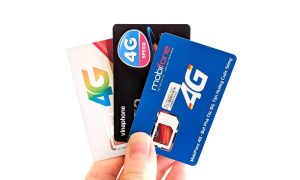Chris and Sofia were impressed with Vietnam after their early-year trip, but they wished they had known a few things earlier to make their journey more fulfilling.
The two American travel vloggers visited Vietnam and explored destinations like Hanoi, Sa Pa, Ninh Binh, and Da Nang. However, they were unprepared in some areas, such as obtaining visas and packing appropriately. As a result, they shared 10 things foreign visitors should know before coming to there to ensure a smoother trip.
Apply for a Visa Early-Vietnam
Chris and Sofia applied for an e-visa about two weeks before their trip but made mistakes in some steps, like entering their names and uploading photos, which led to delays. As their departure date approached, they had to rely on visa service providers and pay higher fees. The couple advises applying for a visa at least two weeks in advance to avoid complications.

Sun Protection
If planning to stay in VN for one to two months, Sofia recommends bringing a large bottle of sunscreen beforehand. She found that sunscreens in VN often include additional features like skin brightening and spot fading. However, Sofia preferred pure sunscreens that focus on UV protection and are gentle on the skin, so she stuck with her product from the U.S. She also noted it can be challenging to find similar sunscreens in many Asian countries.

Additionally, Sofia advises preparing long-sleeved shirts and pants for sun protection, which can be easily removed if needed. She purchased a sun-protection jacket at a local shop and described it as “super lightweight, comfortable, and breathable.”
“You need to be well-prepared because the sun here can burn your skin in 15-20 minutes without protection,” she said.
Clothing Preparation
When shopping for clothes in VN, Sofia noticed sizes typically range from very small, small, to medium. Even stores offering larger sizes often max out at XL, making it challenging to find XXL or bigger sizes like those available in the U.S.
For Western visitors like Sofia, finding properly fitting jeans can be quite difficult. She recommends either choosing Western brands or opting for tailor-made clothing to ensure a perfect fit.
Motorbikes
Sofia described VN’s traffic as “rather chaotic” due to the high number of motorbikes. However, she rented a motorbike and found it to be an exciting experience.
The traveler emphasized the importance of having an international driver’s license to avoid issues when driving in VN. For those looking for a beautiful, less crowded city to ride around, Da Nang is an ideal choice.
Currency
Vietnamese money is denominated in “thousands of dong,” which can make spending feel like “a lot.” However, with 1 USD equaling approximately 30,000 VND, expenses are not very high. Since Sofia was unfamiliar with the denominations, she occasionally gave too much money, but the shopkeepers returned the excess. This honesty left her with a strong impression of Vietnam.
Vegetarian Cuisine
Sofia was surprised by the variety of vegetarian and vegan options in Vietnam, calling it one of the “most diverse countries for plant-based food.” She also tried several meat substitutes and described it as an amazing experience.
“If I had known earlier, I would have visited Vietnam sooner,” she said.

>>>Top 10+ Vegetarian Restaurants in Hanoi that are Delicious and Healthy
>>>Compilation of the Best Vegetarian Restaurants in Saigon Across Districts part 1
Coffee
Although Sofia and her boyfriend are not big coffee drinkers, the unique ways Vietnamese people prepare coffee made her “addicted” to it. The two most memorable types were coconut coffee and salted coffee. Additionally, the drink is very affordable, costing around $2 or less for a large cup.

“Cafés are everywhere, and you can work comfortably in them,” Sofia shared, adding that she’s been drinking coffee daily since arriving in Vietnam.
>>>TOP 5 special things about Vietnamese coffee culture
SIM Cards
At the airport, travelers can easily find SIM card vendors. However, Sofia discovered that SIM cards are cheaper outside the airport. She used an Airalo eSIM for traveling across multiple countries but found physical SIM cards in Vietnam more cost-effective.
For instance, Airalo’s plans cost nearly $5 for 1GB valid for 7 days or $7 for 2GB valid for 15 days. In contrast, physical SIM cards in Vietnam cost about 20,000–50,000 VND ($1–2), with customizable 4G or 5G data packages. If planning a longer stay, Sofia recommends opting for a physical SIM card.

Ride-Hailing Services
“Vietnam’s ride-hailing services are the fastest in Southeast Asia,” Sofia remarked. While she had used similar services in Thailand, they were more time-consuming. In Vietnam, these services are quick and convenient, offering motorbike rides, car rides, and food delivery. She suggests downloading the apps immediately upon arrival as they’ll be essential.
Facebook Groups
Sofia and her boyfriend didn’t use Facebook much before, but since they started traveling, it has become a valuable tool for finding information. In Vietnam, Sofia noticed there are many Facebook groups tailored to specific interests, such as tennis, yoga, beach volleyball, and nightlife. She found these communities welcoming and a great way to gain unique experiences.
Sofia herself joined a few groups and played tennis with new friends. Additionally, groups are often region-specific. For example, while in Da Nang, she joined a group for expats in Da Nang to stay updated on local events and activities.
![]() Visa FOPA Company
Visa FOPA Company
📞+84 906 044 975 (Mr. Do)


